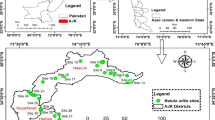Abstract
We used a simulation approach to study the trade-off between forest harvesting and the conservation of arboreal marsupials in managed eucalypt forests of south-eastern New South Wales (Australia). The EDEN gap model is used to predict tree biomass harvested and the resulting shifts in habitat quality (HQ) for arboreal marsupials under different harvesting scenarios. These harvesting scenarios generate a gradient of biomass harvested by varying rotation length and tree retention in different topographic positions. The results suggest that the shape of the curve of reduction of HQ along the harvesting gradient is very sensitive to topographic position and hence to the proportion of topographic units in the landscape. Consequently arboreal marsupial management in logged forests will be region-dependent as each region will have its own pattern of landscape complexity.
Similar content being viewed by others
References
Austin, M.P. 1978. Vegetation. In: M.P. Austin and K.D. Cocks (eds.). Land use on the South Coast of New South Wales. Vol. 2. Biophysical Background Studies. pp. 4467. CSIRO. Melbourne. Australia.
Austin, M.P., A.O. Nicholls and C.R. Margules, 1990. Measurement of the realized qualitative niche: environmetal niches of five Eucalyptus species. Ecol. Monogr. 60: 161-177.
Austin, M.P., J.G. Pausas and A.O. Nicholls, 1996. Patterns of tree species richness in relation to environment in southeastern New South Wales, Australia. Aust. J. Ecol. 21: 154-164.
Botkin, D.B., J.F. Janak and J.R. Wallis, 1972. Some ecological consequences of a computer model of forest growth. J. Ecol. 60: 849-872.
Braithwaite, L.W., J. Turner and J. Kelly, 1984. Studies on the arboreal marsupial fauna of eucalypt forests being harvested for woodpulp at Eden, New South Wales. III. Relationships between faunal densities, eucalypt occurrence and foliage nutrients, and soil parent materials. Aust. Wildl. Res. 11: 41-48.
Chapin III, F.S., E.D. Schulze and H.A. Mooney, 1992. Biodiversity and ecosystem process. Trends Ecol. Evol. 7: 107-108.
Franklin, J.F. and R.T.T. Forman, 1987. Creating landscape patterns by forest cutting: Ecological consequences and principles. Landscape Ecol. 1: 518.
Hansen, A.J., S.L. Garman, B. Marks and D.L. Urban. 1993. An approach for managing vertebrate diversity across multipleuse landscapes. Ecol. Applications 3: 481-496.
Hansen, AJ., S.L. Garman, J.F. Weigand, D.L. Urban, W.C. McComb and M.G. Raphael, 1995. Alternative silvicultural regimes in the Pacific Northwest: Simulations of ecological and economic effects. Ecol. Applications 5: 535-554.
Lindenmayer, D.B. 1994. Wildlife corridors and the mitigation of logging impacts on fauna in woodproduction forests in southeastern Australia: a review. Wildl. Res. 21: 323-340.
Lindenmayer, D.B. and H.P. Possingham, 1994. The Risk of Extinction: Ranking Management Options for Leadbeater's Possum using Population Viability Analysis. CRES, Canberra.
Lindenmayer, D.B., R.B. Cunningham, M.T. Tanton, H.A. Nix and A.P. Smith. 1991. The conservation of arboreal marsupials in the montane ash forests of the Central Highlands of Victoria, southeast Australia: III. The habitat requirements of Leadbeater's possum Gymnobelideus leadbeateri and models of the diversity and abundance of arboreal marsupials. Biol. Conserv. 56: 295-315.
Lindenmayer, D.B., R.B. Cunningham and C.F. Donnelly, 1993. The conservation of arboreal marsupials in the montane ash forests of the Central Highlands of Victoria, southeast Australia. IV. The distribution and abundance of arboreal marsupials in retained linear strips (wildlife corridors) in timber production forests. Biol. Conserv. 66: 207-221.
Margules, C.R. and T.D. Redhead, 1995. BioRap: Guidelines for using the BioRap Methodology and Tools. CSIRO, Canberra.
Pausas, J.G., M.P. Austin and I.R. Noble, 1997. A forest simulation model for predicting eucalypt dynamics and the habitat quality for arboreal marsupials. Ecol. Appl. 7.
Pausas, J.G., L.W. Braithwaite and M.P. Austin, 1995. Modelling habitat quality for arborealmarsupials in the SouthCoastal forests of New South Wales, Australia. For. Ecol. Manage. 78: 39-49.
Pressey, R.L., C.J. Humphries, C.R. Margules, R.I. VaneWright and P.H. Williams, 1993. Beyond opportunism: key principles for systematic reserve selection. Trends Ecol. Evol. 8: 124-128.
Shugart, H.H. 1984. A Theory of Forest Dynamics. SpringerVerlag, New York.
Shugart, H.H. and I.R. Noble, 1981. Acomputermodel of succession and fire response of the highaltitude Eucalyptus forest of the Brindabella Range, Australian Capital Territory. Aust. J. Ecol. 6: 149-164.
Strasser, M.J., J.G. Pausas and I.R. Noble, 1996. Modelling the response of eucalypts to fire in the Brindabella Range, ACT, Australia. Aust. J. Ecol. 21: 341-344.
Turner, M.G., G.J. Arthaud, R.T. Engstrom, S.J. Hejl, J. Liu, S. Loeb and K. McKelvey, 1995. Usefulness of spatially explicit population models in land management. Ecol. Applications 5: 1216.
TyndaleBiscoe, C.H. and J.H. Calaby, 1975. Eucalypt forest as refuge for wildlife. Aust. For. 38: 117-133.
Urban, D.L. and H.H. Shugart, 1992. Individualbased models of forest succession. In Plant Succession: Theory and Prediction. pp. 249-291. Edited by D.C. GlennLewin, R.K. Peet and T.T. Veblen. Chapman and Hall, London.
Author information
Authors and Affiliations
Rights and permissions
About this article
Cite this article
Pausas, J.G., Austin, M.P. Potential impact of harvesting for the long-term conservation of arboreal marsupials. Landscape Ecology 13, 103–109 (1998). https://doi.org/10.1023/A:1007984630592
Issue Date:
DOI: https://doi.org/10.1023/A:1007984630592




